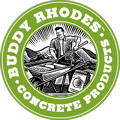Reinforcing A Concrete Countertop | Withstanding The Force
How do I reinforce a concrete countertop?
How can I make it stronger?
Does it need steel rebar?
What needs to happen to make your concrete object strong enough to withstand the conditions it will encounter? Whether your are a DIYer making your own concrete countertops, or a professional concrete artisan, the basic principles are simple enough to understand. Here are some ideas that will help you determine the answer questions for your specific situation. The first thing is to understand the two main forces that you will often hear referred to in the realm of concrete-compression and tension.
Let's keep it simple.
TENSION- the force that causes an object to pull apart.
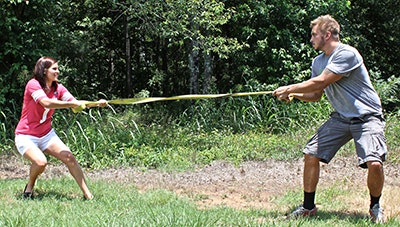
COMPRESSION- the force that causes an object to be crushed
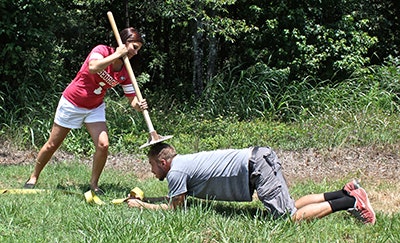
Buddy's mixes are designed with very high compressive strengths. You are not going to have to worry about crushing them. Tension, on the other hand, is an achilles heal of concrete. This is the area that needs to be considered when planning your project. Tension is why steel is used in concrete, to keep it from pulling apart. It is important to make the distinction of "pulling apart" as opposed to "bending and cracking". This common misconception drives people to add bigger steel rod in hopes that it will make the concrete more rigid and less likely to bend. This is will cause issues, not solve them.
The next matter to understand is where an object is experiencing tension. When a plane experiences a force, whether from gravity or someone's weight, one side of the plane goes into compression, and the opposite side goes into tension. The side that goes into compression is becoming smaller, while the side that goes into tension is trying to get bigger and pull apart from itself. Where does the concrete want to pull apart from itself? The side that is in tension needs reinforcement. Here are 2 images to help illustrate-
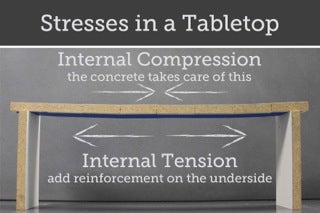
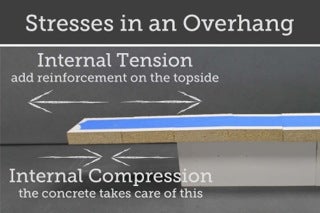
In these images, the blue painters tape represents reinforcement in the planes in need of tensile reinforcement. Blue tape, which is not particularly strong or rigid, does a fine job of holding these individual blocks together in a plane. This speaks back to the point of trying to keep the object from pulling apart, rather than simply trying to support it or make it more rigid, our same objective with concrete.
As you see in these images, one plane is in compression, and one side is in tension. In some cases you may find that a plane can switch from compression to tension depending on where it is supported and what external stresses are present. Regardless, you want to add reinforcement as close to the plane that is in tension as you can.*This is will help counteract the concrete wanting to pull apart and crack. Reinforcement in the compression plane will not add any protection from stress related cracking.
Now that we understand all of this, what shall we use to reinforce the objects we are making?
There are 2 types of reinforcement that we suggest for use in most objects. Fiber and/or Steel.
Steel is good to use in extreme situations where long spans or cantilevers are in play, or in cases where unusual stresses will be encountered. When using steel, 9ga wire will be plenty big, anything larger is likely to cause cracking. A good material to use is ladder wire as seen on Buddy's cast in place video. You can find this at most of Buddy Rhodes' Distributors or at your local home improvement store. Steel is not recommended for GFRC applications because of the shrinkage that is common in GFRC. Since steel doesn't shrink, this can cause cracking.
Fiber is the most widely used reinforcement in artisan applications. Chopped fiber helps by adding tensile reinforcement throughout the object. All you need to do is add it to your mix.*For both the Craftsman Mix and the GFRC Mix, we recommend 1.5 lb of fiber per bag of mix. The other option in the realm of fiber is Scrim. Scrim allows you to add additional reinforcement in the tension plane (it does the job that the blue tape does in the images above). When applying scrim, you want the scrim as close to the tension plane as possible while still being fully encapsulated in the concrete mix.* Fiber also does a good job of helping reduce shrinkage cracking, something especially important for large castings. Read more about using PVA Fibers here.
*These ideas reflect the technical requirements of the location of reinforcement. This needs to be balanced against the aesthetic requirements. If reinforcement is too close to the finished surfaces, it can show up or create shadows. Whenever placing reinforcement towards the finished surface, you will want be sure your reinforcement is not going to show through. When using fibers, it is common to apply a thin layer of mix without fibers (face mix) on the finished surface. The thinner this mix is, the closer your reinforcement will be to the tension face. Making a small test sample will give you a better feel for your tolerances with your chosen reinforcement.
Still have questions about reinforcing your project?



